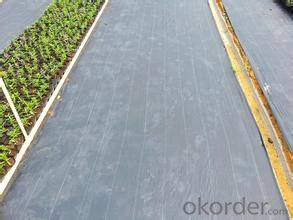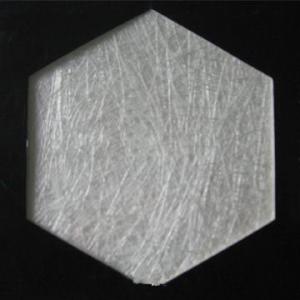Geotextile Under Riprap Silt Fence with Wooden Stake/Weed Barrier Fabric
- Loading Port:
- Qingdao
- Payment Terms:
- TT OR LC
- Min Order Qty:
- 1000 roll
- Supply Capability:
- 100000 roll/month
OKorder Service Pledge
OKorder Financial Service
You Might Also Like
1.Weed Barrier Fabric Description:
Weed Barrier Fabric, is a structure composed primarily of geotechnical fabric and that is used as a form of sediment control.These temporary barriers are relatively low in cost, especially when compared to the damages they can prevent. They keep loose soils from traveling into local bodies of water and they also minimize the impact that various forms of development can have on surrounding wildlife.




2.Weed Barrier Fabric Functions and Features:
1)Excellent weed control
2)Excellent UV resistance
3)Moisture,fertilizers,air reach plants to allow for healthy soil
4)Good water and air permeability
5)Exceptional toughness and strength
6)Durable,tear-resistant,anti-rot and anti-mildew
7)Light weight,easy to install,follows natural ground contours
8)Ideal for use in landscaped beds,under decks and walkways
9)Fashionable design,high quality,competitive price
10)Long service life

3. Weed Barrier Fabric Usage:
1.Prevent leakage disposal in landfill or waste water or waste dregs disposing field.
2.River bank ,lake dam ,mine remainings ,resevoir ,tunnel ,liquid storage pool(pit ,mine)
3.Preventing leakage in subway ,basement ,tunnel ,hole .
4.Anti-salt leakage in roadbed and other ground sill.
5.The plane direction laying of dam ,the vertical direction laying for ground sill.used in the construction fence and waste material field.
6.Used in ground sill of road ,highway ,railway and waterproof layer of welling clay and wet collapsed loess.
7.Preventing leakage on rooftop.


4. FAQ:
Q1: What is your minimum order quantity?
A:The minimum order quantity is 5000 ,but it is negotiable.
Q2:What is your payment terms?
A: T/T,Western Union,Paypal,L/C...
Q3:What is your delivery time?
A:Production time usually costs 2-20 days.
Waiting to cooperate with you!
- Q: Are geotextiles commonly used in rainwater harvesting systems?
- Yes, geotextiles are commonly used in rainwater harvesting systems. Geotextiles act as a filtration layer, preventing the entry of debris and sediment into the harvesting system while allowing water to pass through. This helps to maintain the quality of collected rainwater and prevents clogging or damage to the system.
- Q: What are the specifications for geotextiles in roadways?
- Geotextiles used in roadways should meet certain specifications to ensure their effectiveness. These specifications typically include factors such as tensile strength, puncture resistance, filtration capability, and elongation properties. Additionally, the geotextiles should have appropriate thickness, weight, and permeability to allow for proper drainage and filtration of water. The specifications may vary based on the specific requirements of the road project, but overall, geotextiles in roadways need to be durable, efficient, and capable of enhancing the overall performance and longevity of the road.
- Q: The difference between short wire geotextile and filament geotextile
- Geotextile is a collectively, he includes filament geotextile, short wire geotextile, woven geotextile, woven geotextile, hot pressed nonwovens. Polyester filament geotextile color is mainly white, green. Gray two categories. The length of the fiber is greater than 4.5 cm. Strong strength is very high. Looks very good distinction.
- Q: Can geotextiles be used in railway track bed stabilization?
- Yes, geotextiles can be used in railway track bed stabilization. They are commonly used to improve the stability and performance of the track bed by providing separation, filtration, and reinforcement. Geotextiles help to prevent the mixing and migration of different layers of the track bed, enhance drainage, increase load-bearing capacity, and reduce the risk of track settlement and deformation. Overall, geotextiles play a crucial role in maintaining the long-term stability and durability of railway tracks.
- Q: 300 grams per square meter of anti-geotextile there? what price
- I specialize in producing geotextiles
- Q: Can geotextiles be used in the construction of landfills?
- Yes, geotextiles can be used in the construction of landfills. Geotextiles are often used as a barrier or liner material in landfills to help prevent the migration of contaminants and control the flow of leachate. They are commonly used to enhance the stability, durability, and environmental performance of landfill systems.
- Q: How do geotextiles help in filtration of stormwater?
- Geotextiles help in the filtration of stormwater by acting as a barrier that allows water to pass through while trapping sediment, debris, and pollutants. They prevent these contaminants from entering the drainage system, improving water quality and reducing the risk of clogging in stormwater infrastructure. Additionally, geotextiles promote infiltration, allowing stormwater to percolate into the underlying soil, thus replenishing groundwater levels and reducing the chances of flooding.
- Q: Can geotextiles be used in coastal revetment works?
- Yes, geotextiles can be used in coastal revetment works. Geotextiles are often used in coastal engineering projects as they provide erosion control, stabilization, and protection against wave action and tidal forces. They can be installed as a barrier between the revetment material and the underlying soil, preventing soil erosion and enhancing the overall stability of the revetment structure. Geotextiles also allow for proper drainage and filtration, reducing the risk of sediment buildup and enhancing the longevity of the revetment works.
- Q: How do geotextiles help in preventing the loss of fine particles in geocomposite drains?
- Geotextiles help prevent the loss of fine particles in geocomposite drains by acting as a filter barrier. They allow water to pass through while retaining the fine particles, preventing clogging and ensuring efficient drainage.
- Q: Construction Technology of Seepage Control of Geotextile for Landscape Water System
- Laying HDPE geomembrane should try to weld at least, in ensuring the quality of the premise, as far as possible to save raw materials. But also easy to ensure quality. The lap width of the joint between the membrane and the membrane is generally not less than 10 cm, usually in the direction of the weld arrangement parallel to the maximum slope, that is, along the slope direction. Geomembrane thickness of not less than 0.25mm, too thin may produce pores, and easy to damage in the construction and reduce the anti-seepage effect. Geomembrane construction, in particular, should pay attention to laying should not be too tight, not wrinkled, stitching to be strong. Should be strictly in accordance with technical specifications construction, the good preparation, laying, splicing, inspection and backfill, such as five quality off. I specialize in production and construction
Send your message to us
Geotextile Under Riprap Silt Fence with Wooden Stake/Weed Barrier Fabric
- Loading Port:
- Qingdao
- Payment Terms:
- TT OR LC
- Min Order Qty:
- 1000 roll
- Supply Capability:
- 100000 roll/month
OKorder Service Pledge
OKorder Financial Service
Similar products
Hot products
Hot Searches
Related keywords


































